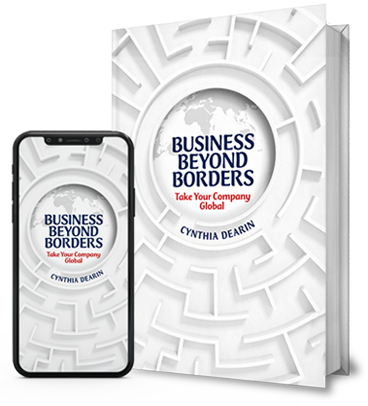Companies encounter a bunch of challenges when it comes to marketing in other countries. Marketing departments often don’t know much about the business and cultural context of the international audiences they are trying to reach. Sometimes they are also unsure about what kind of marketing they should be doing, so they either “copy + paste” – do exactly what has worked for them in their home market, or they take a “spray and pray” approach international marketing – trying a little bit of everything – rather than a targeted approach. And finally, they don’t track their marketing numbers, measure the results and adjust the strategy accordingly. None of these approaches tends to work well. The upshot is that companies that market like this don’t get the results they are hoping for in overseas markets.
Although international marketing operates from the same core marketing principles as domestic marketing, how it works on the ground can be very different, because people in different countries have different expectations.
Let’s take China and the United States as case study examples. Companies the world over dream of winning business in these two superpower economies, and they represent two distinctive kinds of markets: developed Western markets and developing Eastern markets.
The United States and China also differ significantly when it comes to what people care about and what kind of marketing works.
Core values: personal appeal or desire to be seen?

Let’s imagine that Elon Musk and Zhang Zetian (China’s youngest female billionaire) attended the same conference. Which one of them is more likely to dress in luxury brands? If you spent a moment researching Musk and Zetian online, you’d probably conclude that Zetian would show up in a couture outfit, while Musk would be likely to wear a no-name t-shirt and jacket.
As one of the richest and most famous entrepreneurs in the world, Musk doesn’t need to prove himself or get attention with brand name clothes – he’s happy to wear whatever makes him feel comfortable. But as a newcomer to the billionaire scene, Zetian prefers luxury labels because they confirm her financial and social success to anyone who is paying attention.
As you may have guessed, in this illustration Musk represents the US and Zetian represents China. The United States – a developed market – is like Musk. Most consumer goods are affordable and consumers choose products for the benefits that they deliver, not solely on the basis of a brand name. American consumers value how well things work more than what image they project.
China, on the other hand, is a developing market that more closely resembles Zetian. China consumers choose brands to project social status, not just for what they can deliver. Savvy international brands are aware of this and have adapted their brand positioning for the Chinese market. For instance Häagen-Dazs, an American ice-cream brand sold in supermarkets around the world, successfully reinvented itself for the Chinese market as a luxury ice cream brand sold in boutique stores. In China, the ice-cream sells for more than twice what it does elsewhere. Whereas Westerners think of Häagen-Dazs as quality ice cream, Chinese consumers see it as part of a high-end lifestyle.
Product selection criteria: Innovation or Brand Credibility?
Research also suggests that when it comes to choosing products, US consumers prefer “innovative” brands, whereas in China “brand credibility” is the most important factor in choosing one product over another.
This is at least partly because Chinese consumers and manufacturers find themselves in a crisis of trust when it comes to product quality. In the last decade China has been beset by multiple consumer protection scandals – melamine in milk powder, illegal additives in meat, adulterated steamed buns, exploding watermelons primed with growth-promoting chemicals, mercury in baby formula and plastic rice, the list goes on. If food and other consumer products were really compared against the official standards, nearly 50% would be judged substandard.
In a climate of deep mistrust of locally-made products, Chinese consumers look for reassurance when it comes to quality. Large or well-known brands, or those endorsed by word of mouth tend to do well because fame and social proof equal proof of quality and reliability. That’s why advertising in China tends to highlight brand history or product formula history. For example, all local Chinese cosmetic brands, including recently founded ones, like to claim that their product is based on a traditional Chinese recipe, or that they are partnering with a well-known Western brand.
In the United States, quality is more or less guaranteed, consumer protections are highly evolved and product information is readily available. Consumers believe they can access the information they need, and they trust their Food and Drug Administration to protect their safety, so they don’t look to brand associations or history as proof of product quality. Consequently, product innovation is a key factor for American consumers choosing products, and product advertising tends to focus on newness including new benefits, new packaging, or new usage.

Reaching the market
It’s not just how consumers think, what they value and how they choose products that differs between the United States and China, even the mechanics of reaching prospective clients differs.
Online and social media advertising
Whereas Western audiences tend to find online advertising irritating and intrusive, Chinese audiences often welcome well-targeted online advertising as a means of learning about new brands.
And that’s not the only difference.
In the United States, consumers use Facebook, Instagram, Twitter and Snapchat, but Chinese audiences have a far greater array of popular and in-country social media channels at their disposal, including WeChat, Sina Weibo, Tencent QQ and Douyin (TikTok), which is now gaining a global following. Chinese customers also use industry and topic-specific social media platforms, such as Mafengwo for travel and Keep for health and fitness.
I could go on, but the point I’m trying to make here is that you can’t afford to assume that what works in one country will work in another.

International Marketing Success
If you want to create an international marketing strategy that works in the country you’ve chosen, there are a few things you have to get right.
Understand the context
Create a tailored approach
Research, test and measure
And finally, with your strategy in place, you need to research the most appropriate channels to use and then test and measure your results.
Aside from a deep understanding of the context, the key here is to reverse engineer your strategy. Work backwards from where you want to be to work out what you need to do. This includes setting specific goals and a timeline for implementation. If you do these things, your odds of getting great traction in your new market are much, much higher.







